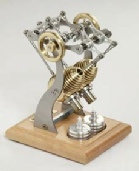a1villas.co.uk 13a.co.uk a1 cd.co.uk a1guns.co.uk a1solar.co.uk a1webcam.co.uk airpistol.co.uk
allwinds.co.uk austin-
 Home
More info
more
info2
Models
Home
More info
more
info2
Models
Subsequent development by Robert Stirling and his brother James, an engineer, resulted in patents for various improved configurations of the original engine, including pressurisation which by 1843 had sufficiently increased the power output for it to drive all the machinery at a Dundee iron foundry[11].
As well as saving fuel, the inventors were motivated to create a safer alternative
to the steam engines of the time[12], whose boilers frequently exploded causing many
injuries and fatalities[13][14]. The need for Stirling engines to run at very high
temperatures to maximize power and efficiency exposed limitations in the materials
of the day and the few engines that were built in those early years suffered unacceptably
frequent failures (albeit with far less disastrous consequences than a boiler explosion[15])
-
Stirling Engine Later nineteenth century developments
Steam boilers were eventually made much safer and development increased the efficiency of the engines themselves, but, though the Stirling engine did not succeed as a competitor to the steam engine as an industrial scale prime mover, during the latter nineteenth and early twentieth centuries smaller engines of the Stirling/hot air type were produced in substantial numbers, finding application wherever a reliable source of low to medium power was required, such as raising water or providing air for church organs[17]. These generally operated at lower temperatures so as not to tax available materials and thus tended to be rather inefficient, their major selling point being that unlike a steam engine they could be operated safely by anybody capable of managing a fire[18]. Several types remained in production beyond the end of the century apart from a few minor changes. improvements the design of the stirling engine in general stagnated during this period
